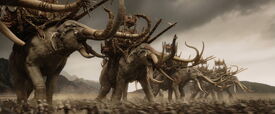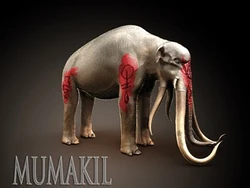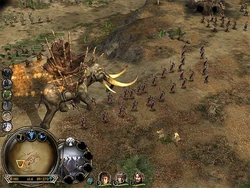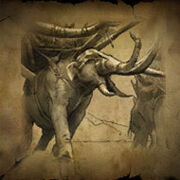Mûmakil (known in Westron as Oliphaunts) were large creatures resembling elephants, often used in battle by the Haradrim. Oliphaunt was the name given to them by Hobbits.
Physical description
Mûmakil have an appearance akin to that of an elephant, sporting thick, arrow-resistant skin, and sharp tusks. The Mûmakil's most defining feature is undoubtedly their vast size, allowing the armies of Mordor to erect war towers on their backs.
Outfitting
Presumably, Mûmakil could be coerced to kneel or lie down so that a tower could be hauled into place, and tied from under the belly. Their elevated position gave arrows and spears a greater range for those riding in the tower.
History
Third Age

Oliphants charging towards the Rohirrim at the Battle of the Pelennor Fields
In southern Harad during the Third Age, there lived beasts of vast bulk thought to be ancestors of elephants, which would be much smaller in size.[1] According to the Red Book, they were bigger than a house.
In the years of the War of the Ring, the fierce warriors of Harad came north to Gondor at the call of Sauron, and with their legions they brought the great Mûmakil, which they used as beasts of war. The Mûmakil that the Haradrim brought to the Battle of the Pelennor Fields were harnessed with red banners, bands and trappings of gold and brass, and on their backs great war towers from which archers and spearmen fought. They had a natural blood-lust, and many foes were crushed beneath their feet. With their trunks they struck down many foes, and their tusks were red with the blood of their enemies. They could not be fought effectively by mounted men, for horses refused to go near them, nor by footmen, who were quickly crushed or shot from above. In war, they would frequently stand as towers that could not be captured; shield walls broke before them and armies were routed around them.
These thick-skinned beasts were almost invulnerable to arrows; their eyes were vulnerable, however, as Mûmakil could be blinded or even killed by arrows released with great force. When blinded they went into a rage of pain, often destroying masters and foes alike in their rampages. Very few Mûmakil were seen after the War of the Ring outside of Far Harad, their natural habitat. It is presumed wild Mûmakil still roamed in Far Harad and that some still were kept by the Haradrim.[2]
Etymology

Mûmakil featured on the book cover of Tolkien's World: A Fantasy Coloring Book
The word Oliphaunt is a variant spelling of the archaic word oliphant meaning "elephant", "ivory", "elephant-tusk", "musical horn made of an elephant tusk", or "a musical instrument resembling such a horn". It appears in Middle English as olifant or olifaunt, and was borrowed from Medieval French olifanz. The French word owes something to both Old High German olbenta "camel", and to Latin elephantus "elephant", a word of Greek origin. OHG olbenta is a word of old Germanic origin; cf. Gothic ulbandus also meaning "camel". However, the form of the OHG and Gothic words suggests it is also a borrowing, perhaps indeed directly or indirectly from Greek elephas (ελεφας), meaning "ivory", though apparently with some confusion as to the animal the word referred to. The word survives as the surname "Oliphant" found throughout the English-speaking world. Olifant is also the Dutch word for elephant.
The most famous use of the oliphant is in The Song of Roland "The oliphant is set to Roland's Lips;" Roland fails to call for help at the Battle of Roncevaux in 778 until it is too late for him and his comrades. The oliphant is echoed in The Lord of the Rings by Boromir's Horn of Gondor and counterpoised by Helm's horn and the horns of Buckland.
Men of Gondor called an Oliphaunt a mûmak (plural mûmakil). The word Oliphaunt is only used by hobbits.

A Mûmak without tower, as rendered for the films
Samwise' poem
Oliphaunt is also the title of a short comic poem about the beast quoted by the hobbit Samwise Gamgee, based on traditional bestiary lore.
- Oliphaunt:
- Grey as a mouse
- Big as a house
- Nose like a snake
- I make the earth shake
- As I tramp through the grass
- Trees crack as I pass
- With horns in my mouth
- I walk in the South
- Flapping big ears
- Beyond count of years
- I stump round and round
- Never lie on the ground
- Not even to die
- Oliphaunt am I
- Biggest of all
- Huge, old, and tall
- If ever you'd met me
- You wouldn't forget me
- If you never do
- You won't think I'm true
- But old Oliphaunt am I
- And I never lie
Portrayal in adaptations
The Lord of the Rings film trilogy

The Mumakil are decorated with scarlet painting by their masters
In Peter Jackson's The Lord of the Rings film trilogy, the Haradrim managed to attach war-harnesses to the backs of the Mûmakil, made of canvas and bamboo. They are depicted as 35 to 45 feet tall, each with four to six tusks. They were designed after the extinct proboscidean, 'Palaeoloxodon antiquus', otherwise known as the 'Straight-tusked elephant'.
The props for the dead Mûmakil shown on the field after the battle were the largest props used in production.[3]
Rankin/Bass The Return of the King
Two Mûmakil are briefly seen pulling the war machine Grond.
Video games

Mûmakil set afire by Rangers of Ithilien in The Lord of the Rings: The Battle for Middle-earth
In the Pelennor Fields level of the Return of the King video game, the player must kill two to a multitude of Mûmakil (depending on how much the Witch-king is damaged each round). They must be killed with ranged weapons. There is also one featured in the Southern Gate level.
In LEGO Dimensions and in LEGO Lord of the Rings, the player must defeat multiple Oliphants.
In The Battle for Middle-earth I and II, the Mordor faction can train Mûmakil. Mûmakil are the strongest and largest regular unit, with their powers only overshadowed by a few heroes and summoned units. A Mûmak is highly resilient against melee attacks, quite vulnerable to pikes, and has five active archers in its tower.

The Mûmakil avatar in the BFME game series
In The Lord of the Rings: Conquest, three Oliphaunts must be killed before they reach the defense zone. In the Pelennor Fields level of the War of the Ring campaign, they can be killed easily with a catapult or by sabotage. They can be controlled on the Rise of Sauron level Weathertop or in the Pelennor Fields level (in Instant action; Team Deathmatch mode only).
In The Lord of the Rings: The Third Age, Mûmakil are enemies at the Pelennor Fields in Good Mode and are playable at the same place in Evil Mode.
In The Lord of the Rings Online, Mûmakil appear in Eastern Gondor as an enemy and are part of several quests.
Unrelated to Lord of the Rings, the game Rome: Total War includes a cheat entered as "Oliphaunt," which creates a unit of "Yubtseb Elephants," massive elephants who greatly resemble Mûmakil. Their name is "Best Buy" spelled backwards, and are said to be the offspring of the fictional god "G'nitek'ram, The God of Shiny Objects Man Does Not Need but Desires Anyway," G'nitek'ram being "marketing" spelled backwards.
Rome: Total War does include a mod called "The Lord of The Rings: Total War", in which the Mûmakil are a unit for the Haradrim army, and another unit called the greater Mûmakil are a used as a bodyguard for the general.
Translations
| Foreign Language | Translated name |
| Danish | Mûmakil (olifant) |
References
- ↑ The Silmarillion, Quenta Silmarillion, Chapter I: "Of the Beginning of Days"
- ↑ The Lord of the Rings: The Return of the King
- ↑ The Art of The Return of the King, Introduction, pg. 8
